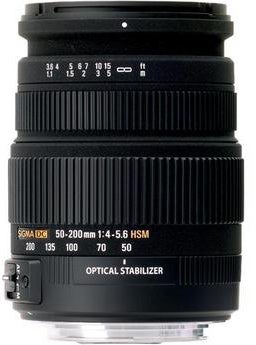A sub-£200 optic with Optical Stabilisation and a Hyper-Sonic Motor - too good to be true or an absolute steal?
Sigma 50-200mm f/4-5.6 DC OS HSM Review
Sigma’s list price for this lens is £300 but it is commonly sold for around half that sum or less, which makes it an absolute bargain if it is as good in the field as it looks on paper.
Being a dedicated APS-C lens the proclaimed 50-200mm focal-length range equates to about 80-320mm on a full-frame camera. This is a very useful range that will suit a variety of picture-taking situations, including portraiture and action photography. It is a shame that the aperture is limited to f/4, and falls to f/5.6 at longer focal-lengths, but this is a reasonable limitation in such a competitively priced lens.
Amazingly, the 50-200mm zoom benefits from a Hyper-Sonic Motor, which makes auto-focusing quick and quiet, together with a (single-mode) optical stabilisation system. It is also said to have internal focussing but that is a little misleading in the sense that, although there is no barrel extension, the focusing ring rotates in AF mode so must be kept unobstructed.
Under normal circumstances a rotating focusing ring would limit the grip that can be taken on the lens but the Sigma 50-200mm has a solid cylindrical lens hood that, when reversed, protects the focusing ring. This in turn allows the user to grip the lens more securely than would otherwise be possible when shooting in AF mode. The hood has a negligible effect on the wide zoom ring, which is located mid-way along the barrel and offers a short throw with just the right amount of resistance.
The AF mode switch and OS on/off switches are both behind the zoom ring. The latter acts counter-intuitively, in that the slider needs to be pulled back towards the camera body to switch-off the OS system: in my opinion it is more common for the off position to be furthest forward.
In terms of technical testing the Sigma 50-200mm zoom exhibits a consistent set of curves that hover around the critical 0.25 cycles-per-pixel level. This is encouraging and it is only really the maximum focal length, at smaller apertures, that slips below the key figure. Equally impressive is the near absence of chromatic aberration, which is detectable in technical images at the 50mm setting but cannot be discerned in real-world photographs.

Verdict
Overall this is clearly an impressive lens - especially given its remarkably low price. Admittedly it doesn't have the feel of a top-flight professional zoom but neither does it feel flimsy or exhibit any serious weaknesses when used within its own limitations. Given that field and technical testing proves this really is the absolute bargain it looks on paper, users who can live without a wide maximum would be well advised to consider Sigma's 50-200mm zoom as a compact yet very capable general purpose lens.





